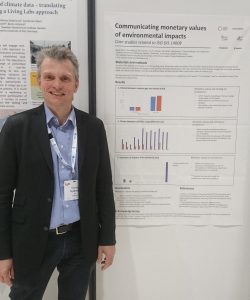Poster from center project presented at SETAC conference
SETAC Annual meeting is a 5-day event featuring a variety of training, networking and learning opportunities and this year it took place in Rome on May 13-17. Tomas Rydberg (IVL Swedish Environmental Research Institute and member of the center network) was there to present a poster from the Swedish Life Cycle Center research project “Development of methodology to communicate environmental damage cost data”, get inspired and interact.
The conference in general covers environmental toxicology and chemistry. When it comes to LCA it covers the entire LCA area, including life cycle perspectives in sustainability assessments, with focus on method development.
We asked Tomas a few questions after the conference:
 Why is this an important context for you and your research?
Why is this an important context for you and your research?
“This is the (only) scientific conference that is at the forefront of method development within, more or less, all parts of LCA, and especially in Impact Assessment. So, of course, it attracts many of those who deal with it in Europe. The opportunity for side meetings is great and is widely used – often these are at least as important as the regular program.”
What were the main topics of the conference?
“There was no clear red thread but I noticed two interesting development tracks:
- More advanced time-solved and space-solved models are being developed, both in inventory and impact assessment. Also models for uncertainty analysis. These are more data-intensive and it is likely that data becomes more and more accessible.
- Environmental benefits are getting more focus, not just environmental damage or costs.”
At the conference, a poster from the center project “Development of methodology to communicate environmental damage cost data” was presented by Tomas. The poster showed results from the three case studies that had been conducted to find out which metadata had the greatest influence on the impact values and in particular the ranking of alternatives by monetary impact values.
Were there any reactions to the poster?
“The poster was very well received! Especially from those with no or little experience from monetary valuation.”
In the case study, the EPS 2015dx method was used to value emissions and resources on a global basis.
If you are interested in learning more about monetary valuation of environmental impacts and EPS:
- Join the web based introduction to EPS, click here.
- Read more about the project “Development of methodology to communicate environmental damage cost data”, click here.
Text: Ulrika Georgsson


